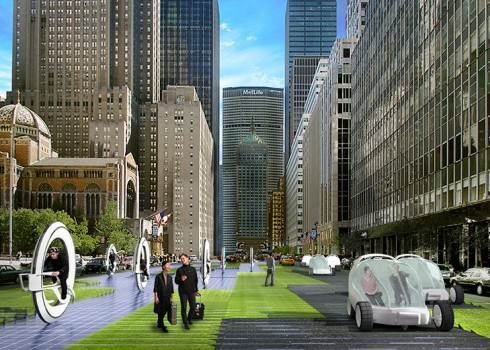The photo below is from MIT Spectrum, a publication of the Massachusetts Institute of Technology. The original caption reads:
Rotating between asphalt, grass and photovoltaic cells, spaces can dynamically shift from city street to park to energy source — on demand. If roads were solar panels, they could power 23.2% of Manhattan. Höweler and Yoon Architecture.
Uh, excuse me, but how did my alma mater, a well-known engineering school, sanction the fantastic collection of impractical ideas? The street is supposed to be made of motorized, three-sided rotating panels and one side is photovoltaic cells? How long would that hold up? Energy costs? Expense? There have been proposals for solar cells in glass block-surfaced pavers on walking surfaces, probably doable, though expensive; photovoltaics have even been suggested as street paving — looks much iffier, but on the other hand, why would it make sense to put solar panels under the pounding wheels of vehicles in New York’s dark concrete canyons or even on rural highways when huge expanses of sun-drenched desert, or even New York City rooftops, stand open? Those wheely things over on the left of the picture? Aside from the difficulty of balancing and steering a monocycle, — it’s been tried (and you don’t have to go any farther than Wikipedia to see how impractical it is) — also, the rider’s pitching backward (“gerbiling”) in hard braking, how would one of these be stored in a New York apartment? It’s hard enough to store a folding bicycle!


Did Massachusetts recently legalize marijuana or something? What, indeed, are the Spectrum editors smoking?
Looks like a “solar bike path” has been built now, and here’s a fairly critical article.